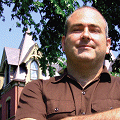2007 Campus Technology Innovators: Social/Community Networking

TECHNOLOGY AREA: SOCIAL/COMMUNITY NETWORKING
Innovator: Tufts University
Using localized social networking to encourage
authentic—and novel—academic connections
across the campus community
Educators and technologists at Tufts University (MA)
believed early on in the potential of Web 2.0 communication
and collaboration tools to enhance teaching, learning, and
research. So, in partnership with three vendors in different
technology areas, and under the guidance of project lead
David Grogan (manager of the Curricular Technology Group,
Academic Technology, UIT), they set out to create the Spark
project, designed as an easy-to-use, integrated
tool suite for the creation of a localized social and
semantic network of knowledge, ideas, and activities. Their
hypothesis: By encouraging the use of these tools in an
authentic academic context, Tufts community members would
make interesting and novel connections among themselves
and with each other's work.
Technology choices. With a set of limited but essential baseline requirements, the Spark team began researching the
"best of breed" for each technology they would need to build
the suite. Baseline requirements included: 1) the ability to
easily integrate with Tufts' LDAP authentication system for single
sign-on, 2) easy user management, 3) flexible user interface,
and 4) scalability.
Tufts’ Spark tools are flexible
enough to meet a wide variety
of instructional, research,
and co-curricular goals.
"We chose blogs and wikis as the flagship tools because
these technologies offered flexible mechanisms to address a
wide variety of teaching, learning, and research use cases,"
reports Amelia (Mely) Tynan, Tufts CIO and VP of information
technology.
In the summer of 2006, the group selected the Movable
Type blog system from Six Apart, and the
Confluence wiki system from Atlassian.
Then the technologists designed a web interface using JSP
and Java servlets that would serve as the single point of entry
to these tools.
Community use and benefit. Spark launched in September
2006, and was immediately promoted to faculty, staff,
and students via newsletters, word of mouth, and individual
consultation. Since the rollout, the team has added a homegrown
podcast publication utility and a discussion tool using JForum.
"By matching instructional goals to the [cost and payback]
of these technologies," says Tynan, "we began building use
cases that could be reused as more people came on board."
Because the department of UIT Academic Technology takes
a very broad view of activities that can be described under the
rubrics of teaching, learning, and research, the Spark website
was designed to give full access to all members of the Tufts
community (faculty, students, staff, and associates).
"Enabling full and easy access to tools for communication
and collaboration will benefit the whole community as more
connections become possible with increased use," Tynan
observes. "We have users representing all Tufts community
types. They are using the system for a variety of purposes:
study blogs, course management, project tracking, collaborative
writing, community portals, publishing podcasts." Other
benefits will be realized as well: "From a technology perspective,"
she adds, "the project has resulted in an architecture that
allows us to quickly integrate, deploy, and experiment with
new tools as their value becomes of interest to the community."
An added plus: "We have been surprised by the flexibility
of these tools to meet a wide variety of instructional, research,
and co-curricular goals. This has enabled the Academic Technology
department to respond in a rapid and agile way to a
large number of requests from clients for custom solutions,"
says Tynan.

SPARK PROJECT LEAD
Grogan and the Tufts team
designed an easy-to-use
tool suite for the creation of
a localized social and
semantic network of
knowledge, ideas, and activities.
Future enhancements will include providing a richer user
interface experience and more cross-tool integration. This
summer, in fact, the project team will implement a variety of
enhancements designed to: 1) make content more visible, to
encourage discovery and connection-making; 2) evaluate
Spark's impact for community constituents; 3) encourage use
of tagging and other social/semantic networking features; and
4) enhance usability.
The Tufts technologists are working closely with their academic
community to explore the potential for the new Spark
technologies within academic domains and workflows. "Working
with constituents to analyze, design, implement, and provide
ongoing support for the use of the tools greatly increases
the chance of the technologies gaining traction," says Tynan.
"The larger goal of the localized social/semantic network of
ideas depends on this interaction and growth of use." She
advises those involved in similar undertakings to be willing to quickly experiment with and possibly discard technologies
as new tools appear and disappear at an
ever-increasing pace.
Will Spark deliver the "interesting and novel" community
connections Tufts educators anticipate?
"We've just spent a week with faculty in our summer
institute," notes Tynan, "and their engagement and
active use of collaboration technologies give us
strong affirmation that Spark has great value. The
potential is enormous."